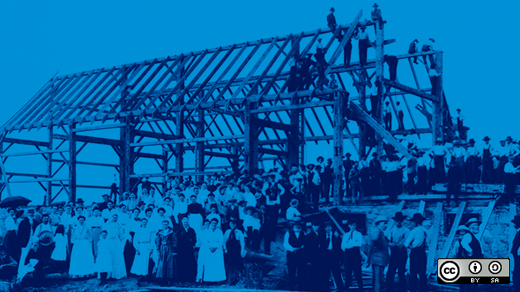Over the last two decades, I have been a member of numerous types of Internet communities and a drive-through visitor at countless more. The technology has varied: email listservs, Usenet, chat rooms, blog commenting, forums and message boards, RPG. Within theses communities the written and unwritten rules are as diverse as the underlying platforms, and these elements combine to make up the culture and communication styles of each group.
Online communities vary from company-sponsored to unaffiliated message boards, from broad focus to highly specialized. Members flock to Television without Pity to snark about American Idol candidates or the Duggar family—commentary that would get them banned from many fan or network television sites—while Kraft product enthusiasts exchange recipes and product reviews on the Kraft Recipes community boards. Communities for knitting and remodeling can be found at That Home Site, and elsewhere you can determine whether you're a real vampire. (Sensitive to bright light? I have bad news for you.)
Following are four steps to take when developing a new online community, as well as insight into what drives the culture of some specific communities that represent a variety of topics and goals.
1. Determine if your community will have a collaborative purpose. Be a community of practice.
Blogger Boris Pluskowski thinks companies shouldn't build communities at all. Though he prefers the word “team,” what he's really describing is a preference for communities of practice: groups of people who share a concern or a passion for something they do and learn how to do it better through regular interaction.
Of course, not every online community has a collaborative purpose. Your own venture might be aimed primarily at reinforcing a brand or engaging customers more deeply. But your chances of success increase substantially if you build a community of practice. When a community convenes to work on a problem or help one another, members are more engaged and less likely to misbehave or violate social norms.
Kids with Food Allergies is a message board for the parents of food-allergic children. The community has over 20,000 members who share tips on everything from administering EpiPen® injections to baking without common ingredients like eggs, milk, or wheat.
Although members have added more than 500,000 posts since its inception, the forum has a surprisingly low rate of heated arguments or flame-baiting, partly because of a standing policy against discussing politics or debating anything outside of food allergies. The folder topics are highly specific: Breastfeeding with Food Allergies, Formula and Special Medical Foods for Food Allergic Kids, Food and Cooking, etc. In addition, the site avoids another source of contention by disallowing the discussion of any medical treatments or therapies that do not currently have “any basis in scientific fact.”
Kids with Food Allergies President Lynda Mitchell credits the leadership and volunteer team with the community's harmony. “The volunteer team for our community leads by example and reinforces the community culture,” Mitchell said. “We have virtual team meetings when problems rarely arise, decide how to respond in a respectful and fair way, and quickly take care of situations so they don't get out of control. We have clear ground rules, spelled out in writing, to use as our guidepost, but we rarely need to invoke any of them because the culture of the community reinforces the expectations we have for our members.”
Unlike lively debate communities, the Kids with Food Allergies message board has grown in the absence of conflict because—as with many medical support forums—its membership is based upon the bond of shared difficulties, as well as the desire to help the newly diagnosed and assist others in finding competent medical advice in members' local (offline) communities.
Similar “helping” communities exist within corporate-sponsored forums, as well. Inuit, maker of QuickBooks and TurboTax software, has created extremely successful help-desk forums staffed largely by members who are simply experienced users of the software. 40 – 70% of these help-desk style questions are now answered on the forums by users with more expertise, saving Inuit many tech support phone calls and providing faster help to customers.
As evidenced by forums like Kids with Food Allergies and the QuickBooks and TurboTax boards, communities of practice provide more than mere discussion points or camaraderie—they unite members to work toward common goals.
2. Decide to what degree—if any—you want to restrict the expression of opposing viewpoints.
There are many reasons why a community might want to maintain a position on an issue. For example, the Association of Clinical Research Scientists is unlikely to desire its email discussion list be taken over by alternative medicine providers who dismiss the value of double-blind research studies. A John F. Kennedy tribute forum would likely prefer to avoid an influx of conspiracy theorists.
To some extent, restriction of speech is necessary in all communities. Back in 2003, Clay Shirkey, a prominent voice on the effects of the Internet, noted that a group is its own worst enemy. The very members who create vibrant, incredible communities can destroy them from within. That's why even those who are strongly opposed to censorship and handling others with kid-gloves ought to consider strategies for avoiding the kind of difficulties that ended the Communitree project:
“[Communitree] was launched when people didn't own computers, institutions owned computers.
Communitree was founded on the principles of open access and free dialogue ... And then, as time sets in, difficulties emerge. In this case, one of the difficulties was occasioned by the fact that one of the institutions that got hold of some modems was a high school. And who, in 1978, was hanging out in the room with the computer and the modems in it, but the boys of that high school. And the boys weren't terribly interested in sophisticated adult conversation. They were interested in ... running amok and posting four-letter words and nyah-nyah-nyah, all over the bulletin board.
And the adults who had set up Communitree were horrified, and overrun by these students. The place that was founded on open access had too much open access, too much openness. They couldn't defend themselves against their own users. The place that was founded on free speech had too much freedom. They had no way of saying 'No, that's not the kind of free speech we meant.'”
To maintain a healthy community, every group needs some structure, guidelines, and leaders. There are countless ways to arrange a community; yet what creates a flourishing environment for one group will be the death of another.
Winner of Nature magazine's Top Science Blog recognition, Pharyngula is both the blog of biology professor PZ Myers and a community of commenters. Filled with biting commentary on creationism, religion, and all manner of pseudoscience, Pharyngula discussions begin with Myer's prolific (and sometimes vitriolic) posts and drift in any number of directions. Moderated only to remove spam and those who repeatedly annoy the host, Pharyngula is alternately described as a gathering place of venomous spiders and a refuge for rationalism. Commenters assist in maintaining the feel of the community by driving away the majority of dissenting voices—whether by fear, embarrassment, exasperation, or intellectual defeat—and fortifying the base with the usual set of inside jokes and lingo unique to any established message board. With the acquisition of its 1 millionth comment looming, Pharyngula is undeniably a successful community valued by its members.
Meanwhile, at MotheringDotCommunity (MDC) readers of Mothering magazine and others drawn to the active community participate in discussions around “natural” family living. Despite its rank as the largest parenting forum on the Internet, a spirit of alternative (outside the mainstream) parenting permeates MDC. The community's user agreement issues precise guidelines to control the content of threads:
“Mothering.com is the website of natural family living and advocates natural solutions to parenting challenges. We host discussion of nighttime parenting, loving discipline, gentle weaning, natural birth, homebirth, successful breastfeeding, alternative and complementary home remedies, informed consent and many other topics from a natural point of view. We are not interested, however, in hosting discussions on the merits of crying it out, harsh sleep training, physical punishment, formula feeding, elective cesarean section, routine infant medical circumcision, or mandatory vaccinations.”
Moderation is heavy-handed to maintain these rules and others, which at times leads to conflict between members and staff when threads are locked or heavily edited. Still, with 150,000+ members and 14.9 million posts, the community is clearly thriving.
3. Think about your ideal community culture
Examine existing forums and email lists to determine what sort of culture you'd like for your own. The atmosphere of a community varies widely, often determining what type of visitor will become a contributing member.
Some questions to consider include:
- Are you aiming for a culture that values individual expression and debate? Or do you want to be supportive and nurturing?
- How do you feel about arguments and grudges between community members?
- Would you prefer to keep dissenting viewpoints a small part of the overall community, exclude them entirely, or leave it up to the members and “let the chips fall where they may”?
- What will be your policy on disruptive members or “misbehavior”? Does it make a difference if they are new or longstanding member?
- Will you allow anonymous users to participate? If so, will you distinguish between these users and the active core membership?
- Would you prefer moderators to be active members of the community or quiet, behind-the-scenes helpers?
- Which is more important to you: the rights of individual members or the preferences of the community?
4. Value the members. Protect the community.
Every online community eventually experiences a conflict of interest, where the rights of the individual conflict with the good of the community. Perhaps a particularly abrasive member is driving away long-time contributors in droves. Or one member is bothered by language commonly used by other members. Any number of events can trigger an exodus.
The way conflicts of interest are addressed often shapes the future direction of the community. In any community, visitors are attracted or repelled by what they find, and the existing group shapes who will join thereafter. It's quite common for a diverse community to become a strongly partisan place within the span of a few months or years, as a vocal minority becomes the overwhelming majority and turns moderates into refugees in search of a new home.
The difference between a chosen community position and groupthink can be negligible, particularly if the chosen community perspective is not an evidence-based position or the community culture includes frequent dog piling on those who so much as politely disagree.
When I was looking through the chapters on communities in The Open Source Way book, I eagerly flipped to the sections, Do not let poisonous people bog down the community and Disable poisonous communication to see how open source leaders handle these problems. Unfortunately those sections are still blank, so it seems this is a problem that plagues even established communities.
Final thoughts
Although I've said much about creating communities, it's important to realize that—without members—a user agreement, some technology, and a handful of moderators can only ever be a potential community. Members are the essence of every community, and the successful community is ever evolving as it integrates member feedback.






5 Comments